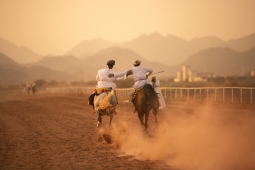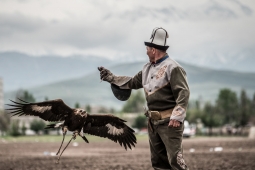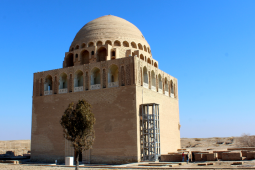Did You Know? The Popularisation of Trousers in China and other Cross-Cultural influences reflected in Clothing
©Shangang Wei / UNESCO Youth Eyes on the Silk RoadsClothing form and design and associated fashions, for both men and women, constituted a significant part of the cultural exchanged facilitated by the Silk Roads. This was particularly true between the steppe and other cultures, where a number of different garment types and design motifs coalesced to form popular fashions that combined design motifs and symbolism from many different societies. These exchanges, which could be mercantile or involve the diplomatic gifting of items of clothing, often fused design motifs, and introduced new materials into regions to create hybrid objects which could be wholly practical or imbued with meaning and reflect social status. As such clothing acted as both an element of material culture transmitted along the Silk Routes as well as a vector for the transmission of culture itself through design motifs, materials, and influences on different popular styles.
As the name suggests, the trade of luxury silk textiles formed a significant part of the exchange of clothing taking place along the Silk Roads. However, many different items were exchanged and in multiple directions in addition to ‘East-West’. Archaeological finds of clothing from along these routes help establish a better understanding of cultural links and contacts as well as reveal much about social structures, resource availability, and economic history of the regions encompassed by these routes. The popularity of silk textiles as clothing is a notable example, but it is by no means the only one, with exchange in clothing norms and fashions flowing in multiple directions not just from the East westwards, but with goods and ideas also running West-East, North-South, and South-North in a complex web of relations.
In particular, the dry climate of western China has preserved many items of clothing from along the Silk Roads including trousers, skirts, and caftans, as well as boots and leather coats and belts, often revealed during archaeological excavations. Of these finds in western China dating from the 1st century BCE to the 3rd century CE, influences from merchants and travellers from the Greco-Roman Empire, Parthia, Sogdia, and the Saka city states of the Kushan Empire at the southern side of the Tarim Basin have been identified in the numerous styles, designs, materials and clothing types uncovered.
One such example of mercantile exchange flowing in a West-East direction is the process of the popularisation of trousers. During the Han Dynasty (221–206 BCE), Mongolian nomads were the primary trade suppliers of horses to neighbouring regions including China. The introduction of Mongolian horses, and with it the practice of horse riding, had a deep impact on Chinese culture, particularly within clothing styles, leading to the widespread adoption of trousers amongst men. Trousers, often paired with a caftan, another item of clothing illustrative of complex cultural interactions, were very popular among the lengths of the Silk Roads as they aided mobility and made horse riding over long distances more comfortable and practical. An interesting example of an early trouser find comes from a grave at Sampula in the Tarim Basin dating from the 1st century BCE. The trousers are made from wool and feature a design of a man holding a spear with a representation of a centaur above him. However, they are unique in that the scale of the design suggests they were in fact fashioned from a repurposed section of a large woollen wall-hanging from the 3rd – 2nd centuries BCE, possibly made in Bactria.
Woven belts were another important item of clothing, considered prestigious possessions in a vast number of societies stretching from the Black Sea to the Mongolian steppe. A fragment of a woven silk belt with an inscription in Greek was uncovered at the Moshchevaya Balka burial complex in the North-Western Caucuses revealing close ties between the Turkic Bulgars in the Northern Caucasus and the Byzantine Empire (330 – 1453 CE). Similar inscribed belt fragments have also been found in nearby areas suggesting a number of such belts were gifted by the Byzantines to important local figures around the same time. Furthermore, another belt, this time a gold medallion belt, perfect illustrates the convergence of a myriad of different influences into one object of status and fashion. This 1st century CE belt comprised of gold medallions which was uncovered at Tillya Tepe archaeological site in the north of modern day Afghanistan. The belt is of a style reminiscent of Scytho-Siberian art however, the repeated gold medallions feature a female figure seated on a lion in the centre, an image which appears derived from Greco-Roman representations of the god Dionysus riding a panther. The figure is also wearing a tunic and pair of buskins (laced leather sandals) that resemble the hunting attire of the Greek goddess Artemis. However, the figure is probably a representation of the Iranian and Central Asian moon goddess Nana who also appears on Kushan coins of the 1st -3rd centuries CE, illustrative of the hybridity of many design motifs of the region.
Dress is an essential facet of social life, in addition to the practical applications of protecting from the elements etc. clothing and other adornments such as belts and jewellery, are cultural expressions of huge influence throughout the ancient and contemporary world. Clothing and fashion intersect with the arts, politics, and science, exerting considerable influence over wider culture. Through a complex network of mercantile exchange, a hybrid language of material culture was established whereby clothing, and transmitted and repurposed design motifs, served as a medium for discourse both between different societies along the Silk Roads and between the individual and society.








